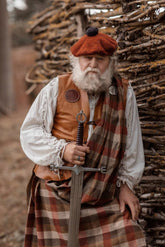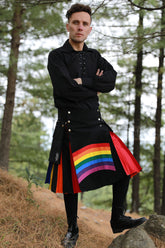Why Black Watch Tartan Still Defines Men’s Fashion
The Black Watch Tartan stands as a symbol of timeless elegance and deep-rooted history in Scottish culture. Known for its bold yet understated pattern, this tartan has become synonymous with tradition, pride, and versatility. When paired with the iconic kilt, it embodies the spirit of Scotland’s rich heritage while remaining relevant in modern fashion. In this article, we delve into the origins, design, and enduring legacy of this Tartan and its relationship with the kilt.
Origins of Black Watch Tartan: A Regiment is Born
The story of the Black Watch tartan begins in the early 18th century with the formation of a Highland military regiment. Officially known as the Royal Highland Regiment, the unit was tasked with maintaining order and preventing clan uprisings after the Jacobite rebellions. The soldiers wore a distinctive tartan that came to symbolize unity, vigilance, and authority.
Often called the "Government Sett," this tartan pattern was designed with practicality in mind. Its dark colors—navy blue, green, and black—offered a form of camouflage suitable for the rugged Highland terrain. Over time, the term "Black Watch" became synonymous not only with the regiment but also with the tartan itself.
Understanding the Design: Symbolism in Color and Pattern
The Black Watch tartan's color scheme is strikingly subdued compared to the more vibrant Highland clan patterns. The navy blue represents loyalty, the green symbolizes the land, and the black denotes strength and solemnity. This triad of colors reflects the core values of the regiment: discipline, protection, and resilience. Wearing a Black Watch tartan kilt not only honors these values but also connects the wearer to a long-standing military and cultural tradition. The tartan's pattern, officially recorded in the Scottish Register of Tartans, adheres to a setted weave structure that has remained unchanged for centuries. While the design may appear simple, its symbolic depth and cultural weight are immense.
Military Prestige: The Black Watch Regiment
As part of the British Army, the Black Watch regiment has a storied past. From the Napoleonic Wars to World Wars I and II, its members distinguished themselves in combat and service. Their tartan was more than uniform; it was a badge of honor.
During ceremonial parades, military funerals, and official events, the tartan was proudly displayed on kilts, plaids, and uniforms. Today, the regiment remains active as part of the Royal Regiment of Scotland, keeping the legacy alive.
Civilian Adoption: From Clanless to Cultural Icon
What sets the Black Watch tartan apart is its accessibility. Unlike most tartans that are tied to specific clans, the Black Watch design is considered a "universal" or "open" tartan. This means anyone—regardless of surname or ancestry—can wear it, making it a favored choice for those who want to celebrate Scottish heritage without clan affiliation.
Its neutrality also made it popular for school uniforms, pipe bands, and Scottish formal wear. The adaptability of the Black Watch plaid helped it cross cultural and geographical boundaries, becoming a familiar sight in both traditional and modern contexts.
The Rise of Black Watch in Fashion
In the latter half of the 20th century, fashion designers began incorporating the Black Watch tartan into their collections. Labels like Ralph Lauren, Vivienne Westwood, and Burberry saw the pattern as a statement piece—bold, classic, and instantly recognizable. From tailored blazers and trousers to scarves, accessories, and the iconic Black Watch tartan kilt, the pattern became a staple in autumn/winter collections. Its appeal lay in its versatility: formal yet casual, bold yet understated. The pattern continues to feature in high fashion and streetwear alike, merging heritage with trend.
From tailored blazers and trousers to scarves and accessories, the Black Watch tartan became a staple in autumn/winter collections. Its appeal lay in its versatility: formal yet casual, bold yet understated. The pattern continues to feature in high fashion and streetwear alike, merging heritage with trend.
Black Watch Tartan in Popular Culture
The tartan has also made appearances in films, television series, and music videos, reinforcing its status as a cultural icon. Celebrities and royals have worn it during public appearances, adding to its prestige. Whether seen on a fashion runway or a period drama, the Black Watch tartan commands attention and respect.
This visibility has further solidified the pattern's place in global fashion history, making it one of the most enduring and beloved tartans.
How to Wear Black Watch Tartan Today
For those looking to incorporate Black Watch into their wardrobe, the options are endless. Traditionalists may opt for kilts, waistcoats, or full Highland dress. Meanwhile, modern enthusiasts can choose from tailored trousers, skirts, and even sneakers.
Thanks to its neutral palette, the tartan pairs well with a variety of colors and styles. Whether you're attending a wedding, a business function, or a casual outing, Black Watch provides an elegant nod to heritage without compromising on contemporary flair.
The Black Watch Tartan Kilt in Modern Fashion
This Tartan kilt has transcended its military origins to become a staple in modern fashion. Its neutral yet striking color palette makes it versatile and adaptable to various settings. Fashion designers worldwide have embraced the tartan, incorporating it into everything from tailored suits to accessories like scarves and ties.
For those looking to make a statement, this Tartan kilt offers a perfect blend of tradition and modernity. It can be styled for formal occasions with a crisp white shirt and jacket or dressed down with a sweater and boots for a casual look. This adaptability has ensured its popularity across generations and cultures.
The tartan’s influence extends beyond kilts, finding its way into high-fashion collections and casual streetwear. Its association with elegance and heritage has made it a favored choice for those seeking timeless sophistication. Accessories such as pocket squares, handbags, and even footwear now feature the Black Watch Tartan, further broadening its appeal.
Cultural Impact and Legacy
The Black Watch Tartan’s influence extends far beyond Scotland. Its adoption in global fashion and its presence in international events have made it a symbol of Scottish heritage worldwide. The tartan has appeared in movies, music videos, and even high-profile runway shows, showcasing its enduring appeal.
Its legacy is not only about aesthetics but also about what it represents: unity, strength, and a deep connection to the past. Whether worn as a kilt or featured in modern apparel, this Tartan continues to inspire and captivate.
In addition to fashion, the tartan’s cultural significance is celebrated in art, literature, and media. It serves as a reminder of Scotland’s rich history and the enduring relevance of its traditions. The Black Watch Tartan stands as a bridge between the past and the present, connecting generations through its timeless design.
Caring for Your Black Watch Garments
To maintain the quality and vibrancy of your Black Watch tartan clothing, it's essential to follow proper care guidelines. Wool-based garments should be dry-cleaned or hand-washed with care. Store them in breathable garment bags and avoid prolonged exposure to direct sunlight.
Proper maintenance ensures that your pieces not only last for years but also retain their symbolic and aesthetic value.
Conclusion
The Black Watch Tartan and its iconic kilt are more than just garments; they are symbols of Scottish history, culture, and pride. From its origins with the Black Watch regiment to its place in modern fashion, this tartan tells a story of resilience and tradition. Whether you’re a history enthusiast, a fashion aficionado, or someone seeking to embrace Scottish heritage, this Tartan kilt offers a timeless and meaningful choice. Celebrate its legacy, wear it with pride, and carry a piece of Scotland’s spirit wherever you go.
Frequently Asked Questions
What is the origin of the Black Watch Tartan?
This Tartan originated with the Black Watch regiment in 1725, serving as their uniform and a symbol of their unity and discipline.
Can anyone wear a Black Watch Tartan kilt?
Yes, this Tartan is considered a universal pattern, making it suitable for anyone to wear and enjoy.
What occasions are suitable for wearing a Black Watch Tartan kilt?
The kilt can be worn for a variety of occasions, including weddings, formal events, cultural festivals, and even casual gatherings.
How has the Black Watch Tartan influenced modern fashion?
The tartan’s versatility and timeless design have made it a popular choice in global fashion, appearing in clothing, accessories, and even interior design.
What makes the Black Watch Tartan unique compared to other tartans?
Its dark and neutral color palette, historical ties to the Black Watch regiment, and adaptability in both traditional and modern contexts make it a standout among Scottish tartans.















